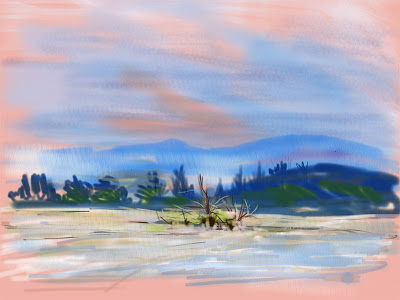Thursday, January 31, 2013
CONISTON WATER
John Ruskin was regarded by Kenneth Clark - former Director of the National Gallery - as one of the finest watercolour painters of the late 19th Century. A few days ago I came across a watercolour he painted of Brantwood his house on Coniston Water. This prompted me to try an iPad watercolour simulation.
I worked from a half-sheet watercolour which I painted some years ago. It's a view from the southern end of lake looking towards the ConistonFells which make a fine backdrop. I wanted to try for the soft colours which are produced by thin transparent washes. Even working as I did on four layers it proved difficult to capture the same effect.
Wednesday, January 30, 2013
HOBBY AT MINSMERE 2
One thing leads to another! I came across an article about David Hockney's iPad paintings in the Daily Telegraph app and discovered he works with the BRUSHES App. So I just had to give it a go.
I've used it to add some finishing touches to the Hobby painting in the last post. I downloaded BRUSHES 3. It's a simple bit of software – easy to use. The only drawback is that the basic version does not have a layers feature but you can purchase it as an add on.
Mr Hockney's iPad paintings made with BRUSHES are astonishing - an inspiration for anyone following the digital trail. For the moment though I think I'll stick with Sketchbook Pro which has more features and I'm getting used to it.
Saturday, January 26, 2013
Hobby in long grass, Minsmere
This is another iPad painting of the Hobby this time using Sketchbook Express. I'm trying out different iPad drawing apps to find one which suits me. Sketchbook Express has more painterly features than Sketchbook Ink so the bird's feathers and the long grass are treated in a more interesting way.
Thursday, January 24, 2013
iPad Sketch made with Autodesk Pro
I was disappointed with my first iPad sketch made with Sketchbook Ink. I was working from a line and wash sketch and I lost my way somewhat. I decided the next attempt would be more considered.
In this post I’m using Autodesk Pro – a more sophisticated app. It has a range of ‘brushes’ for producing different effects and it allows the use of layers which makes planning the work easier. I was working in front of the subject – a view across the Teme Valley – from the comfort of my living room.
I worked directly rather as an oil painter might when sketching en plein air. I flood filled the base layer then worked on three extra layers for different treatments of each stage. It was late afternoon with mist forming and with backlit clouds. Nice atmospheric qualities which were beyond my grasp working digitally.
Wednesday, January 23, 2013
Jackdaws on St, Catherine's Hill, Winchester.
This painting has taken a long time to reach completion. It was developed from preliminary studies that were the subject of previous blogs. I've used an acrylic primed board and and worked almost entirely in Golden Open Acrylics.
Tuesday, January 22, 2013
GOING DIGITAL
I’ve always had a soft spot for David Hockney; there’s no doubting his talent he was noticed early on during his later student years at the RCA. Sir Hugh Casson said ‘he drew like a dream.’ A recent BBC Country File programme showed him making use of an iPad as a sketching tool. Well out of curiosity I had to try my hand at digital sketching.
I searched the Daily Telegraph mobile site where there was an article on sketching apps for the iPad and downloaded the Auto desk Sketch (ink)App. Here’s my first attempt with it – a reworking of a line and wash sketch sketch of a Hobby
Monday, January 21, 2013
DABCHICKS ON THE RIVER ITCHEN
Christmas
New Year and birthday celebrations of of the way I'm looking forward
to completing paintings that have been put hold. Finishing is a slow
process with me I like to have paintings around in temporary frames
because – for me – that is the only sure way to pick up the
passages which are not working properly.
I've
used Golden Open Acrylics on primed MDF board for this painting of
Dabchicks Their slow drying properties are what appeals and the only
minor failing of the colours is that they are transparent are except
for the whites. But there are ways of working round this and glazing
by using a gell medium is easy.
Subscribe to:
Comments (Atom)







